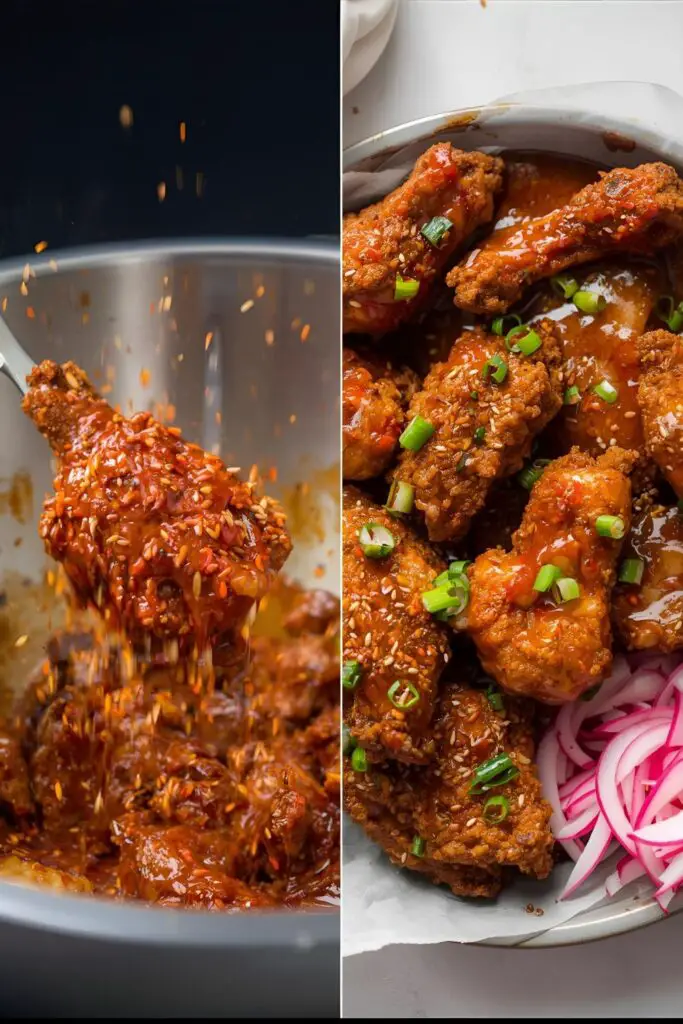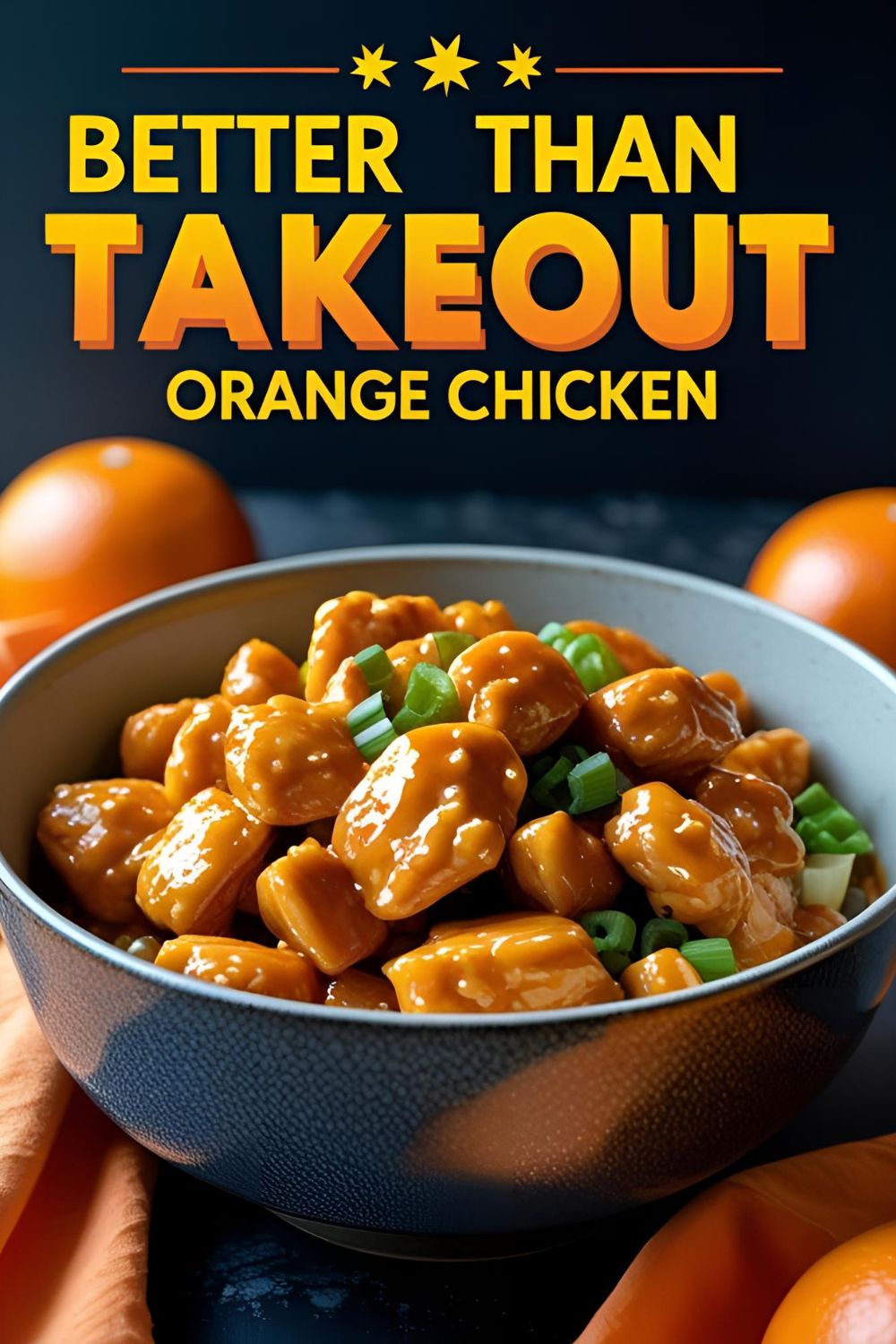Crispy Korean Fried Chicken: Your Guide to Sweet, Spicy, Sticky Bliss
Alright, let’s have a talk about fried chicken. You think you know it, right? You’ve had the buckets, the tenders, the Sunday dinner specials. But I’m here to tell you to throw out everything you think you know. We’re about to enter a new dimension of crispy, a parallel universe of crunch so profound it will change your life. We’re making Korean Fried Chicken.
This isn’t your grandma’s fried chicken (no offense to your grandma). This is a masterclass in texture and flavor. We’re talking about a paper-thin, shatteringly crisp coating that stays crunchy even after being slathered in a sweet, spicy, and savory sauce that is, frankly, addictive. If you’re ready to make a korean chicken recipe so good it’ll make you want to stand up and applaud your own dinner, then you’ve come to the right place. Even with the Khulna heat, this is worth turning the stove on for.
Why This Recipe is Basically a Religious Experience
So, why go through the trouble of frying chicken twice? (Yes, twice. More on that later). Is it really worth the effort? My friend, the question is, are you worthy of this chicken?
First, THE CRUNCH. IS. LEGENDARY. We’re using a special technique that creates a crust so light and crispy, you’ll hear it from across the room. It’s a completely different texture from the thick, craggy crust of American-style fried chicken. This is delicate, shatteringly crisp perfection.
Second, the sauce is everything. We’re talking about that iconic sweet, spicy, and savory gochujang-based glaze that clings to every nook and cranny of the crispy chicken. It’s a flavor profile that hits every single one of your taste buds and leaves them begging for more.
Finally, this is a showstopper meal. You bring a platter of this out for game night or a get-together, and you will instantly become the most popular person in the room. It’s impressive, it’s interactive (in a messy, wonderful way), and it’s just plain cool.
The A-List Ingredient Lineup
To create this masterpiece, you’ll need a few key players. Some might require a trip to a larger grocery store, but they are absolutely worth it.
For the Chicken & Its Crispy Armor:
- 2 lbs Chicken Wings (separated into flats and drumettes) or Boneless, Skinless Thighs (cut into 1-inch chunks): Wings are classic, but thighs are incredibly juicy and easy to eat.
- 1/2 cup Potato Starch or Cornstarch: This is the secret to the light, crispy crust. Do not substitute with all-purpose flour!
- 1 tsp Salt:
- 1/2 tsp Black Pepper:
- 1 tsp Garlic Powder:
For the Addictive Sauce:
- 1/4 cup Gochujang (Korean Chili Paste): This is the heart and soul of the sauce. It’s savory, a little sweet, and has a deep, spicy flavor. This is a non-negotiable ingredient.
- 1/4 cup Honey or Corn Syrup: For that signature sticky sweetness and shine.
- 1/4 cup Soy Sauce: For that salty, umami depth.
- 1 tbsp Rice Vinegar: To add a little tang and cut through the richness.
- 2 tbsp Brown Sugar:
- 2 cloves Garlic, minced:
- 1 tbsp Ginger, freshly grated:
For Frying & Garnishing:
- 4-6 cups Neutral Oil, for frying (like Canola, Vegetable, or Peanut):
- Toasted Sesame Seeds and Chopped Green Onions, for garnish:
Your Fry Master Toolkit
To achieve crispy greatness, you’ll need the right gear.
- A Heavy-Bottomed Pot or Dutch Oven: A deep, sturdy pot is essential for safe deep-frying.
- A Deep-Fry or Candy Thermometer: Absolutely critical. Guessing the oil temperature is a recipe for greasy or burnt chicken.
- Tongs or a Spider Strainer: For safely adding, moving, and removing the chicken from the hot oil.
- A Wire Rack set over a Baking Sheet: This is non-negotiable for draining the chicken and keeping it crispy.
- A Large Mixing Bowl: For tossing the chicken in that glorious sauce.
- A Small Saucepan: For simmering your sauce to perfection.
The Path to Crispy Nirvana: Step-by-Step
Ready to create the best fried chicken of your life? Focus up. This is where the magic happens.
Step 1: Prep and Coat the Chicken
Pat your chicken pieces thoroughly dry with paper towels. Moisture is the enemy of crispiness! In a large bowl, toss the dry chicken pieces with the salt, pepper, and garlic powder. Add the potato starch or cornstarch and toss until every piece is lightly and evenly coated. It should look like it’s been dusted with a fine powder.
Step 2: Make the Magic Sauce
In your small saucepan, combine all the sauce ingredients: gochujang, honey, soy sauce, rice vinegar, brown sugar, minced garlic, and grated ginger. Whisk everything together. Bring the mixture to a simmer over medium heat and let it bubble gently for 3-5 minutes, stirring occasionally, until it has thickened slightly and looks glossy. Keep it warm on low heat.
Step 3: Heat the Oil
Pour your oil into the heavy-bottomed pot until it’s about 2-3 inches deep. Attach your deep-fry thermometer to the side of the pot. Heat the oil over medium-high heat until it reaches 350°F (175°C).
Step 4: The First Fry (The Cooking Fry)
Carefully, using your tongs, add a batch of the coated chicken to the hot oil. Do not overcrowd the pot! This will cause the oil temperature to drop dramatically. Fry in batches, cooking for about 5-7 minutes, until the chicken is cooked through and a very light golden color. It won’t be super crispy yet. Remove the chicken from the oil and let it drain on the wire rack. Repeat with the remaining chicken, making sure the oil returns to 350°F between batches.
Step 5: The Second Fry (THE CRISPY FRY!)
This is the secret. Once all the chicken has been fried once, turn the heat up and bring the oil to 375°F (190°C). Now, add the chicken back to the pot, again in batches, and fry for another 1-2 minutes. You’ll see it transform, becoming deeply golden brown and incredibly crisp. Remove it back to the wire rack to drain.
Step 6: Sauce ‘Em Up and Serve FAST!
Place all of your double-fried, ridiculously crispy chicken into your large mixing bowl. Pour the warm, sticky sauce all over the chicken. Using a spatula, quickly toss everything together until every piece is coated in that glorious glaze.
Immediately transfer the sauced chicken to a serving platter. Garnish with a sprinkle of toasted sesame seeds and chopped green onions. Serve right away while the crunch is at its absolute peak.
Calories & Nutritional Info
Let’s be clear: this is an indulgent treat. This is not health food. But for the sake of information, here’s a rough estimate per serving (assuming the recipe makes 4 servings):
- Calories: Approximately 600-800 kcal
- Fat: Around 35-50g
- Carbohydrates: Roughly 30-40g (mostly from the sauce)
- Protein: About 30-35g
- Note: This is a glorious, deep-fried, sugar-and-spice-coated masterpiece. Enjoy it on a day when you’re not counting calories.
Common Mistakes to Avoid (Or, How to Not Ruin Your Masterpiece)
- Skipping the Double Fry: I know it seems fussy, but this is the entire secret to the texture. The first fry cooks the chicken; the second fry creates the shatteringly crisp crust. Don’t skip it.
- Ignoring the Oil Temperature: If you don’t use a thermometer, you’re flying blind. Oil that’s too cold will make your chicken greasy. Oil that’s too hot will burn the outside before the inside is cooked. Use a thermometer!
- Overcrowding the Pot: This is the fastest way to get soggy, sad chicken. It drops the oil temperature and steams the chicken instead of frying it. Fry in small batches.
- Saucing Too Early: Do not sauce the chicken until you are literally seconds away from putting it on the table. The goal is to eat it at its peak crispiness.
- Using All-Purpose Flour for the Coating: While you can, it will result in a heavier, denser crust. For that signature light, crackly Korean-style crunch, potato starch or cornstarch is vastly superior.
Variations & Customizations
Feel like playing with your food? I support that.
- “Soy Garlic” Chicken (Ganjang Chicken): Not a fan of spice? Make a non-spicy but equally addictive sauce by combining soy sauce, a lot of minced garlic, a little ginger, and some honey or rice syrup. Omit the gochujang completely.
- Extra FIRE Chicken (Buldak Style): If you’re a true spice fiend, up the gochujang and add a tablespoon or two of gochugaru (Korean chili flakes) to the sauce. Maybe even a drop of pure capsaicin extract if you have a death wish.
- Korean Fried Cauliflower (Vegetarian/Vegan): This works beautifully with cauliflower! Make a simple batter of flour, starch, and cold water. Dip cauliflower florets in the batter, double-fry them just like the chicken, and toss them in the sauce (use a vegan honey substitute like agave if needed).
Frequently Asked Questions (Your Crispy Conundrums)
1. What is gochujang and is there a substitute? Gochujang is a fermented Korean chili paste that’s savory, sweet, and spicy. There is no perfect substitute for its unique flavor. In a desperate pinch, you could try a mix of sriracha and a little white miso paste, but it really won’t be the same. It’s worth seeking out!
2. Can I make this in an air fryer? Yes, but it won’t be as crispy. Coat the chicken as directed, spray it generously with oil, and air fry at 375°F (190°C) for about 15-20 minutes, flipping halfway. For the “second fry,” increase the temp to 400°F (200°C) and cook for another 5 minutes until extra crispy.
3. What’s the real reason Korean fried chicken is so crispy? It’s a combination of the thin, starchy batter (which absorbs less oil) and the double-frying process, which renders out even more moisture and fat from the coating, making it incredibly light and crisp.
4. Can I make the sauce ahead of time? Yes! The sauce can be made up to a week in advance and stored in an airtight container in the refrigerator. Just gently reheat it before you’re ready to toss with the chicken.
5. What do you serve with Korean fried chicken? The classic pairing is pickled daikon radish (danmuji), which provides a cool, tangy contrast to the rich chicken. A simple bowl of steamed rice and some kimchi are also perfect companions.
6. Can I use boneless, skinless chicken breast? You can, but it’s much more prone to drying out. If you do, cut it into chunks and be very careful not to overcook it during the first fry. Thighs or wings are highly recommended for the best results.
7. Why did my chicken come out soggy? The most likely culprits are: oil temperature was too low, you overcrowded the pan, or you didn’t pat the chicken dry enough before coating it.
Final Thoughts
Congratulations! You are now in possession of a recipe that is dangerous in its deliciousness. You have unlocked the secret to one of the world’s most addictive forms of fried chicken. You are a culinary rockstar.
So go forth, be brave, and embrace the double fry. Make a batch for your friends, or make a batch just for yourself (we won’t tell). Just be prepared for the fact that regular fried chicken might be ruined for you forever. You’ve been warned. Enjoy the crunch!




